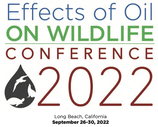Integrating Wildlife into the Larger Oil Spill Response Abstracts
Watch Videos (Login required)
|
Introducing the Updated Wildlife Protection Guidelines for Oil Spill Response in Alaska
Angela Matz U.S. Fish and Wildlife Service Alaska Region Full Abstract
The Wildlife Protection Guidelines for Oil Spill Response in Alaska (WPG) were recently updated by the Alaska Regional Response Team’s (ARRT) Wildlife Protection Committee. State and federal wildlife and response agencies, tribes, NGOs, and industry partners contributed to the 2020 version, which replaced the 2012 version. The WPG organization was updated to match Area Contingency Plans, and to meet both responder and planner needs. Easy-to-use flowcharts and tables were added, as were new tactics for wildlife observation and carcass collection. We have hosted several outreach, training, and testing events tailored to specific audiences, which have included agency, OSROs/PRACs, industry, and wildlife contractors. The WPG is hosted on the ARRT’s website and linked prominently on the State of Alaska Dept. of Environmental Conservation’s Spill Response website. The development process was collaborative and the final document reflects the cooperative nature of wildlife response in Alaska. |
Assessing views and capabilities of emergency response practitioners
toward preparedness for wildlife response and conservation initiatives during disasters Mendy Garron Canisius College NOAA National Marine Fisheries Service Full Abstract
Many wildlife species are vulnerable to impacts from hundreds of natural and anthropogenic disasters that occur globally on an annual basis. Response to wildlife during a disaster can vary worldwide from local levels to international responses. Furthermore, emergency response infrastructure varies across geographic regions, and priorities specific to wildlife responses and conservation monitoring are even more variable within and across infrastructures. The views of emergency response practitioners toward preparedness for wildlife response during disasters are likely to influence how conservation challenges are addressed during disaster responses. This exploratory study examined the views and capabilities of emergency response practitioners toward preparedness for wildlife response and conservation initiatives during disasters. A structured survey method was used to survey members of the International Association of Emergency Managers (IAEM), Regional Response Teams, and employees of state and federal emergency management agencies. The Animal and Human Solidarity Measure (Amiot and Bastian, 2017), the Wildlife Value Orientation Scale (Fulton, Manfredo, and Lipscomb, 1996), and additional Likert-scale survey questions were used to assess wildlife views, along with collection of relevant demographic data. Quantitative data analysis was performed to explore relationships between wildlife priorities and emergency response decision-making. The results of this study can impact contingency planning and conservation programs by integrating identified wildlife views and resource needs into planning efforts by emergency response entities. The need for this type of data is increasing to mitigate climate change impacts to wildlife and biodiversity, and results can benefit global emergency response professionals as well as wildlife research and conservation communities. |
Designed in California?
Assessing regional and national preparedness systems for oiled wildlife response and the global influence of the California model Paul Kelway Oil Spill Response Ltd Full Abstract
The importance of having a multi-year, pro-active approach to wildlife response preparedness has become more widely recognised internationally over the years. Subsequently, more examples now exist of regional and national systems that incorporate multiple stakeholders and aim to integrate wildlife response more effectively into oil spill response systems. The California Oiled Wildlife Care Network (OWCN) is one of the most well-known examples of this approach and has demonstrated what can be achieved through the combined application of academic rigor, programmatic funding and multi-stakeholder partnering. Through a series of interviews with stakeholders in California as well from other national and regional preparedness initiatives in Europe, the Americas and Asia Pacific, this paper will reflect on key developments and lessons-learned from the California system and how it has influenced and compares to other national and regional approaches. Through a qualitative analysis, this paper will look to identify if there are common principles that underpin successful models and to explore to what extent different systems face common challenges. In doing so, this paper will attempt to draw out insights and recommendations that may be of relevance to other countries and regions seeking to address gaps in wildlife response preparedness. |
|
The Netherlands:
Reality Check of a Multi-year Preparedness Programme Simone Jay Sea Alarm Full Abstract
No abstract |

